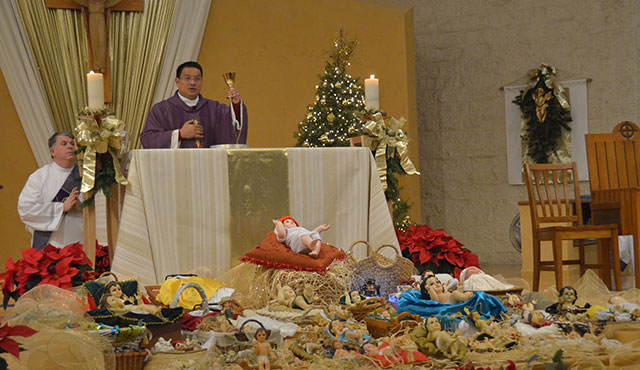Advent is a season of hope and anticipation. All Catholics are invited to celebrate the season the Filipino way, with a nine-day Novena of Masses at Santiago de Compostela Church in Lake Forest that begins on Dec. 16.
The Most Rev. Kevin W. Vann, Bishop of Orange, will preside over the third Mass on Dec. 18. Each day for nine consecutive mornings, Mass will be held at 5:30 a.m., culminating with the last Mass on Dec. 24, Christmas Eve. At the final Mass, devotees are invited to bring their “Bambinos” or Baby Jesus from their Nativity sets to be revered and blessed.
Simbang Gabi was adapted from the Catholic Misa de Gallo, which literally means “Mass of the rooster,” to indicate it is held when the rooster crows. This event dates back to the time when Miguel Lopez de Legazpi celebrated the first feast of the Nativity in the year 1565 in the Philippine archipelago.
Simbang Gabi traces its roots in Mexico when, in 1587, Fray Diego de Soria, head of the convent of San Agustin Acolman, petitioned the Pope for permission to hold Christmastide Masses outdoors because the church could not accommodate the multitude that attended the dawn services. When the request was granted, the Masses became known as Misa de Aguinaldo.
It was in the 16th century when Pope Sixtus V decreed that these pre-dawn Masses also be held in the Philippines starting every Dec. 16. The decree was in keeping with the nine-day traditional festivals of Filipinos in celebrating auspicious occasions like harvest times. It was also meant to give farmers a chance to hear Mass before setting out for the fields. Rural Filipinos were used to starting the day two hours before sunrise. Church bells rang to call the faithful to Simbang Gabi. In some provinces, brass bands played traditional Christmas music and parish priests would go as far as knocking on the doors of every home.
During this season, Filipinos create beautiful decorations called “parol” or paper lanterns to commemorate the Star of Bethlehem. These parols were used by the farmers to guide them in the dark to the Holy Mass. After Mass, the parishioners treated themselves to traditional “Puto, Kutsinta and Bibingka,” made with sweet rice dough to crown each of the nine-day novena and truly celebrate Christmas, the Filipino way.

